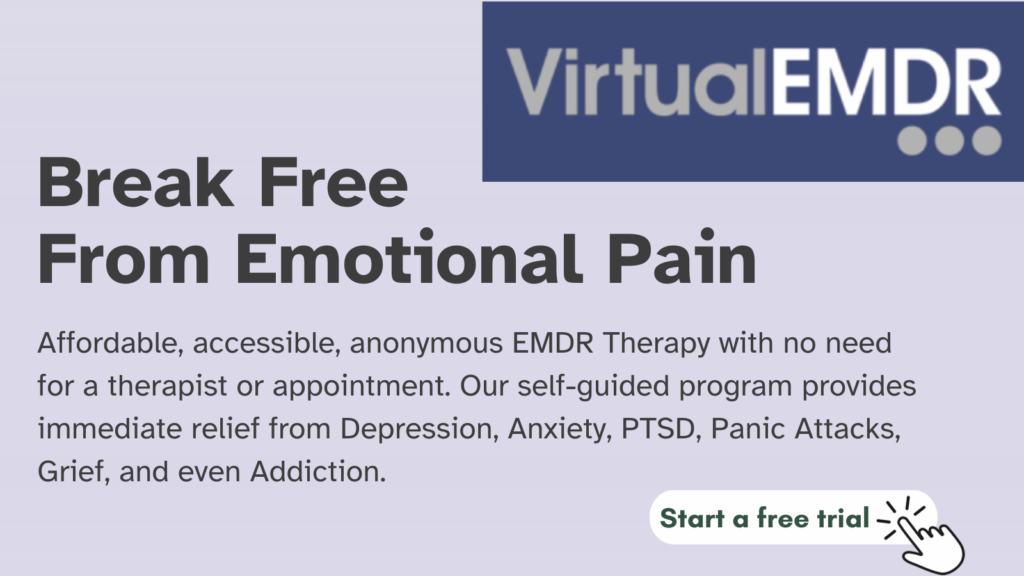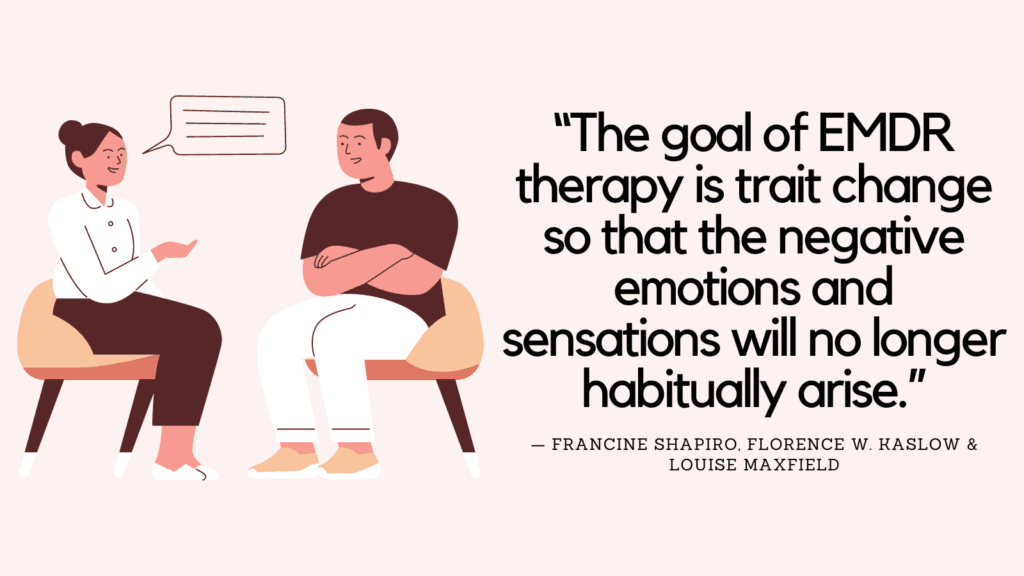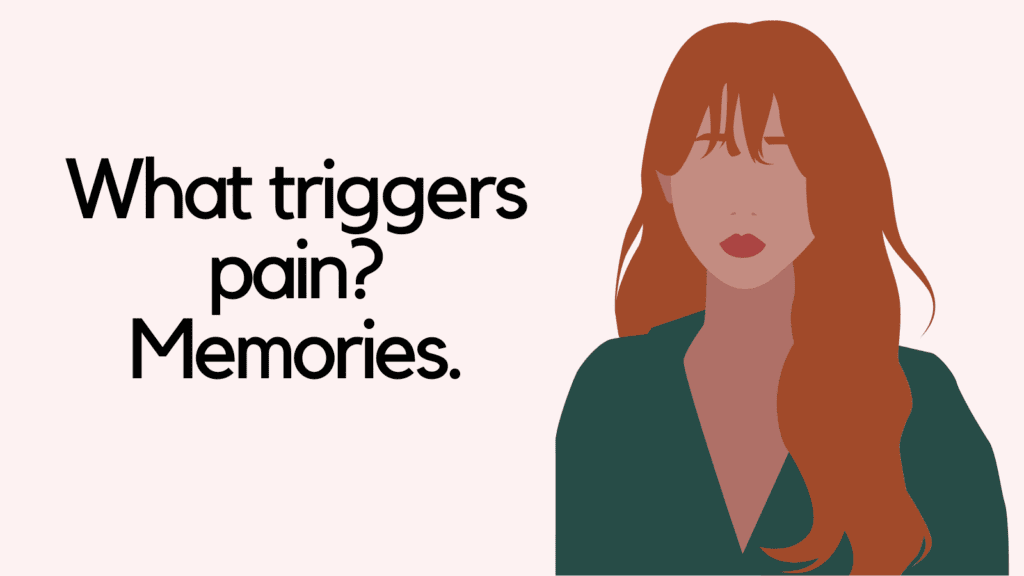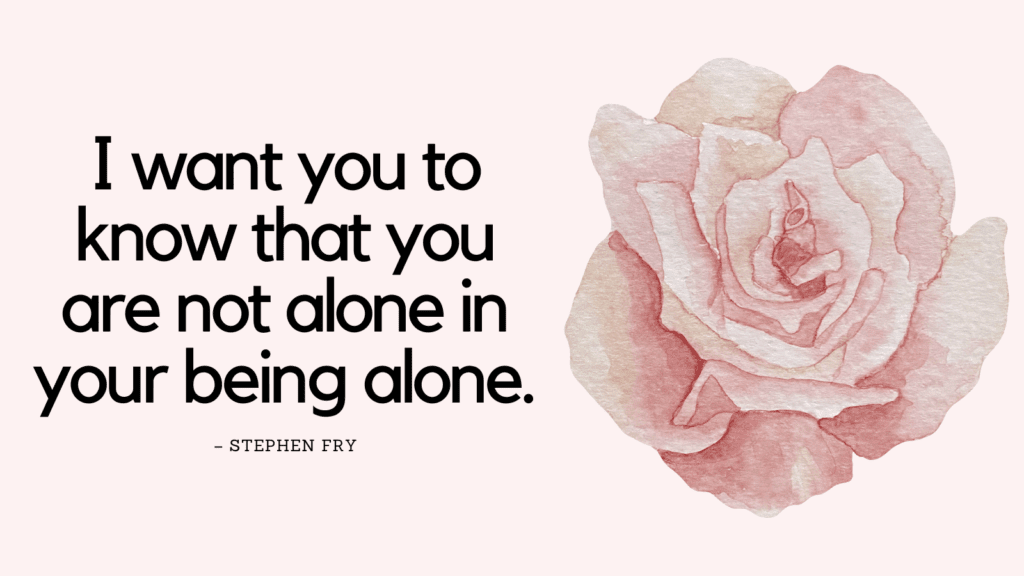This post contains some of the best EMDR therapy quotes.
What Is EMDR Therapy?
EMDR (Eye Movement Desensitization and Reprocessing) therapy is a form of psychotherapy that was initially developed to help individuals process traumatic experiences.
It has since been expanded and adapted to address a broader range of mental health concerns, including anxiety, depression, phobias, and other distressing memories or experiences.
EMDR therapy utilizes bilateral stimulation, which can involve eye movements, taps, or sounds, to stimulate both sides of the brain.
This bilateral stimulation helps the individual access and process traumatic or distressing memories or experiences in a structured and supported way.
The goal of EMDR therapy is to assist individuals in reprocessing traumatic or distressing memories so that they can integrate them into their overall life experiences without the same level of distress or negative impact.
Through a series of carefully structured phases, EMDR therapy enables clients to identify and address maladaptive beliefs, emotions, and sensations associated with the targeted memory.
The process typically involves the client recalling the traumatic memory or distressing event while simultaneously engaging in bilateral stimulation.
As the therapy progresses, the intensity of the distress associated with the memory tends to decrease, allowing the individual to develop more adaptive coping skills, insights, and beliefs.
EMDR therapy is evidence-based and has been shown to be effective in reducing trauma-related symptoms, such as flashbacks, nightmares, and intrusive thoughts.
It is important to note that EMDR therapy may not be suitable for everyone, and it is recommended to consult with a qualified mental health professional to determine if it is appropriate for your specific needs and circumstances.
EMDR Therapy Quotes
1. “EMDR is a psychotherapy approach that employs an eight-phase model of treatment to address the full range of clinical complaints caused or exacerbated by prior negative experiences.”— Francine Shapiro, Florence W. Kaslow & Louise Maxfield
2. “During EMDR, both the protocol and the bilateral stimulation contribute to the simultaneous activation of previously disconnected elements of neural, mental, and interpersonal processes. This simultaneous activation then primes the system to achieve new levels of integration.”— Francine Shapiro, Florence W. Kaslow & Louise Maxfield
3. “The goal of EMDR therapy is trait change so that the negative emotions and sensations will no longer habitually arise.”— Francine Shapiro, Florence W. Kaslow & Louise Maxfield
Related: Do I Have Trauma? Top 4 Practical Exercises To Support Your Trauma Healing
4. “If we understand that traumas, nightmares and bad memories of adverse situations are stored in a mal-adaptive form in the brain networks, then we can begin to understand how EMDR can reprocess these fears, phobias, terrors, and anxieties that are connected to painful memories that keep victims trapped by these ghosts from the past.”— Esly Regina Carvalho
5. “With the new therapeutic approaches that reprocess painful and traumatic memories such as EMDR, therapists are more able to help people deal with dissociation in a way that allows the memories to integrate in a healthier fashion.”— Esly Regina Carvalho
6. “The thing that EMDR therapy does so beautifully is to remove the barrier so that the client can begin connecting the positives and safety of the present with the pain of the past. This —the facilitation of access and integration of memory information—is a good thing about standard EMDR procedures.”—Jim Knipe
Related: 7 Trauma Release Exercises To Support Your Recovery After Trauma
7. “In all cases, EMDR treatment entails processing the past events that have set the groundwork for current dysfunction, the present situations that bring up the disturbance, and templates for appropriate future action.”— Francine Shapiro, Florence W. Kaslow & Louise Maxfield
8. “EMDR work with complex PTSD requires a high level of awareness of the typical characteristics of dissociative disorders, and the importance of establishing sufficient feelings of safety with dissociative clients, at all phases of therapy.”— Jim Knipe
9. “This EMDR is magic…!”—Esly Regina Carvalho
10. “Funny, this EMDR stuff… It’s like it never happened to me. It’s like the EMDR put that experience in a place where it never happened. It’s like I used to look at a room filled with old stuff and now it’s all gone. Everything is organized and I can’t even remember what it was like before!”—Esly Regina Carvalho
Related: Why Is Trauma Therapy So Hard? (+Best Trauma Healing Exercises To Support Your Recovery)
11. “EMDR is a powerful and effective therapy for the treatment of trauma.”— Laurel Parnell
12. “Why EMDR? EMDR works fast, is integrative, doesn’t necessitate prolonged exposure (which can be re-traumatizing), and requires no homework. It activates natural processing capacities of the brain that are frozen and deactivated by trauma. It re-establishes disrupted communication between the brain regions impacted by traumatic experience and enables the traumatized brain to heal.”—Laurel Parnell
13. “The standard EMDR procedures used to process the disturbing experiences are geared to access the memories as they are currently stored, stimulate the information processing system, and monitor the transmutation of the information to an adaptive resolution.”— Francine Shapiro, Florence W. Kaslow & Louise Maxfield
Related: How to Practice Self-Brainspotting Safely?
14. “EMDR is based on the idea that negative thoughts, emotions, body sensations, and behaviors are the result of unprocessed memories.”— Laurel Parnell
15. “In addition to the treatment of PTSD, EMDR is also used to treat the psychological effects of smaller traumas that manifest in symptoms of depression, anxiety, phobias, low self-esteem, creativity blocks, and relationship difficulties.”— Laurel Parnell
16. “EMDR zaps false guilt, but true guilt has to be dealt with in another way”—Esly Regina Carvalho
17. “Not only does healing occur much more rapidly than in traditional therapy, but as a result of EMDR’s clearing of emotional and physical blockages, many people also experience a sense of joy, openness, and deep connection with others. EMDR is a quantum leap in the human ability to heal trauma and maladaptive beliefs”— Laurel Parnell

Related: Brainspotting Risks and Side Effects
18. “Perhaps the greatest joy we have as EMDR therapists is to hear our patients, when they have finished reprocessing their memories, tell us things like… “It’s over. Now it’s distant. It’s in the past.” And when they come back in the following sessions they say: “I remember, but it doesn’t bother me anymore.””— Esly Regina Carvalho
19. “EMDR not only helps to “unfreeze“ the roles, but it also helps to develop a new internal perspective – and a positive one – about how life can be better.”— Esly Regina Carvalho
20. “Research by Hase, Schallmayer & Sack found EMDR to be helpful in reducing addiction craving and in preventing relapse. They concluded that “EMDR might be a useful approach for the treatment of addiction memory and associated symptoms of craving.””—Laurel Parnell
21. “EMDR gives the brain a second chance to reprocess the traumatic memory, thus transforming it into an adaptive resolution.”— Esly Regina Carvalho
Related: Brainspotting Vs EMDR (Which One Is More Effective?)
22. “After EMDR therapy, your memories may seem faded. Some bits of information, deemed unimportant to our survival and future well being, may be completely discarded. However, EMDR does not delete memories.” – Katherine Andler
23. “Although it has directive elements, EMDR is primarily directed by the client—therapists are instructed to “stay out of the way” during the processing phase of EMDR.” – Carol Forgash & Margaret Copeley
24. “Dr. Shapiro has argued that EMDR is not hypnosis, since it does not involve formal hypnotic inductions. Indeed, the trancelike state of mind in which the EMDR client often works is not the same as in deep hypnosis, and EMDR therapists do not use hypnotic inductions.” – Carol Forgash & Margaret Copeley
25. “Dual attention stimulation (bilateral eye movements and tapping) unlocks the unprocessed memory, releases the painful emotions and sensations, and allows the brain to let go of the beliefs that hold us back.” – Katherine Andler
26. “EMDR uses bilateral stimulation, or side-to-side eye movements, to reprocess disturbing memories.” – Katherine Andler
27. “Most therapists recommend around six sessions of EMDR, although for severe trauma a client may need around fifteen sessions, and those with multiple traumas may need many more.” – Katherine Andler
28. “One of the fascinating features of EMDR is that clients don’t need to go into detail about the cause of their trauma; they only need to be thinking about it during the therapy. This focus on the trauma rather than the event may be one of the reasons it is effective. It certainly makes it a more user-friendly treatment amongst clients who may be experiencing shame around their symptoms.” – Katherine Andler
29. “Painful experiences (once processed properly) make us stronger and wiser, and prevent us from having to go through the same experiences again. EMDR simply changes the way painful memories are stored, so that when we think about them they no longer trigger negative emotions or sensations.” – Katherine Andler
30. “Research has indicated that the bilateral eye movements performed in EMDR may replicate the rapid eye movements (REM) during the dream stage of sleep. Scientists have long believed that during REM sleep our brains process the events of the day, including our emotions, beliefs and physical sensations.” – Katherine Andler




